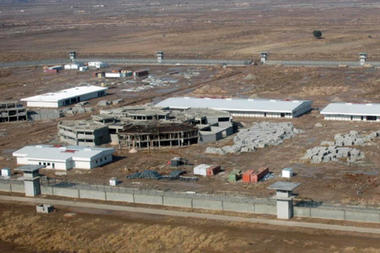How more than $8 billion in US taxpayers' money went to waste in Iraq
A report on US spending in Iraq released today found that of the $60 billion spent there, at least $8 billion, or 13.3 percent of it, was wasted.
The Khan Bani Saad Correctional Facility, outside Baghdad, is seen from the air. Ten years and $60 billion in taxpayer funds later, Iraq is still so unstable and broken that even its leaders question whether US efforts to rebuild it were worth the cost.
Special Inspector General for Iraq Reconstruction/AP/File
During the course of the nine-year US presence in Iraq, at least $8 billion – or 13.3 percent of US reconstruction spending – was wasted, according to the final report released today by the Special Investigator General for Iraq Reconstruction.
he report, entitled Learning From Iraq: A Final Report From the Special Inspector General for Iraq Reconstruction, offered a detailed assessment how $60 billion in American taxpayer money was spent in Iraq during the war. Of that sum, about $25 billion went to training and equipping the Iraqi security forces, while the remainder went an array of development projects ranging from infrastructure construction to governance improvement programs.
The report offers several case studies demonstrating waste, including a project to reconstruct a bridge and oil and gas pipeline in northern Iraq. Geologists advised against drilling in the Tigris River to do the repair work because the soil was too sandy. Engineers ignored the report and spent tens of millions of dollars before the drilling plan was aborted.
The Iraqi reconstruction program was the second-largest nation building effort ever undertaken by the US, superseded only by Afghanistan, where appropriations for reconstruction spending are nearing $100 billion.
RECOMMENDED: Who's who in Iraq after the US exit?
Several Iraqis interviewed for the report now question the value of the money that was spent, saying even the money that can be accounted for was not spent wisely or in such a way that will bring about enduring changes in Iraq.
“There exists limited tangible evidence of any positive effects from the rebuilding program,” wrote the report's authors, summarizing an interview with Iraqi Minister of Minister of Finance Rafi al-Eissawi. “It was a mistake to launch a huge number of programs across numerous geographic and infrastructure sectors rather than devote resources to a finite number of worthy and well-focused projects.”
Mr. Eissawi is a native of Fallujah, a city in Western Iraq that was a focal point for the US throughout the war and scene to some of the fiercest fighting. There, the US constructed a $108 million wastewater treatment facility (and paid $99.8 million of the total cost). When it was completed, the plant served only 38 percent of those its designers estimated it would help. In the end this proved a major cause of frustration for a number of Iraqis.
The report provides a case study of the controversial Fallujah Waste Water Treatment System, highlighting a number of problems that plagued reconstruction projects throughout Iraq.
“Limited planning, a minimal understanding of site conditions, an unskilled workforce, and no clear idea about how much the system would cost burdened the project,” explained the report’s authors.
The plant was intended to remove raw sewage from the streets in Fallujah and improve public health by reducing the risk of contaminated water supplies. According to initial estimates in 2004, when completed the plant would serve 100,000 people after only 18 months of construction at a cost of $35 million. By the time it was completed in 2011 it served only 38,400 after 88 months of construction and a total cost of $108 million.
By comparison, Eissawi said that many residents still have positive memories of the British presence in Fallujah during the 1920s because they built a critical bridge over the Euphrates River that is still in service today.
The size and scope of Iraqi reconstruction was largely a result of the eagerness of the US military and their civilian counterparts to launch a counterinsurgency. The strategy relies heavily on separating the local population from insurgents, and gaining locals' support by providing them with services and assistance. Throughout both the Iraq and Afghanistan wars, soldiers commonly used and use terms such as employing “money as a weapon.”
In his description of the second battle of Fallujah in 2004, US Marine Lieutenant Colonel Leonard DeFrancisci wrote in the Military Review that the Marines sought to undercut insurgent strength by using “a powerful weapon – money – to drive a wedge between the insurgents and the people and help win the second battle of Fallujah.”
Lt. Col. DeFrancisci wrote that the Marines passed out a considerable sum of money meant to meet Iraqis’ immediate needs and settle disputes. He attributes the program with helping to win the support of large segments of the population.
Such thinking and strategies were prevalent throughout the Iraq war, with the US military often conducting programs such as microgrant initiatives, where US soldiers gave Iraqis cash with extremely limited oversight.
In its final recommendations the report urges that future development spending be delayed until there is a reasonable amount of stability and that initial projects scale back their ambitions and scope. It also suggests oversight of projects starting at their inception.
